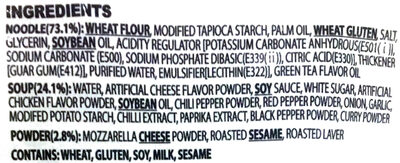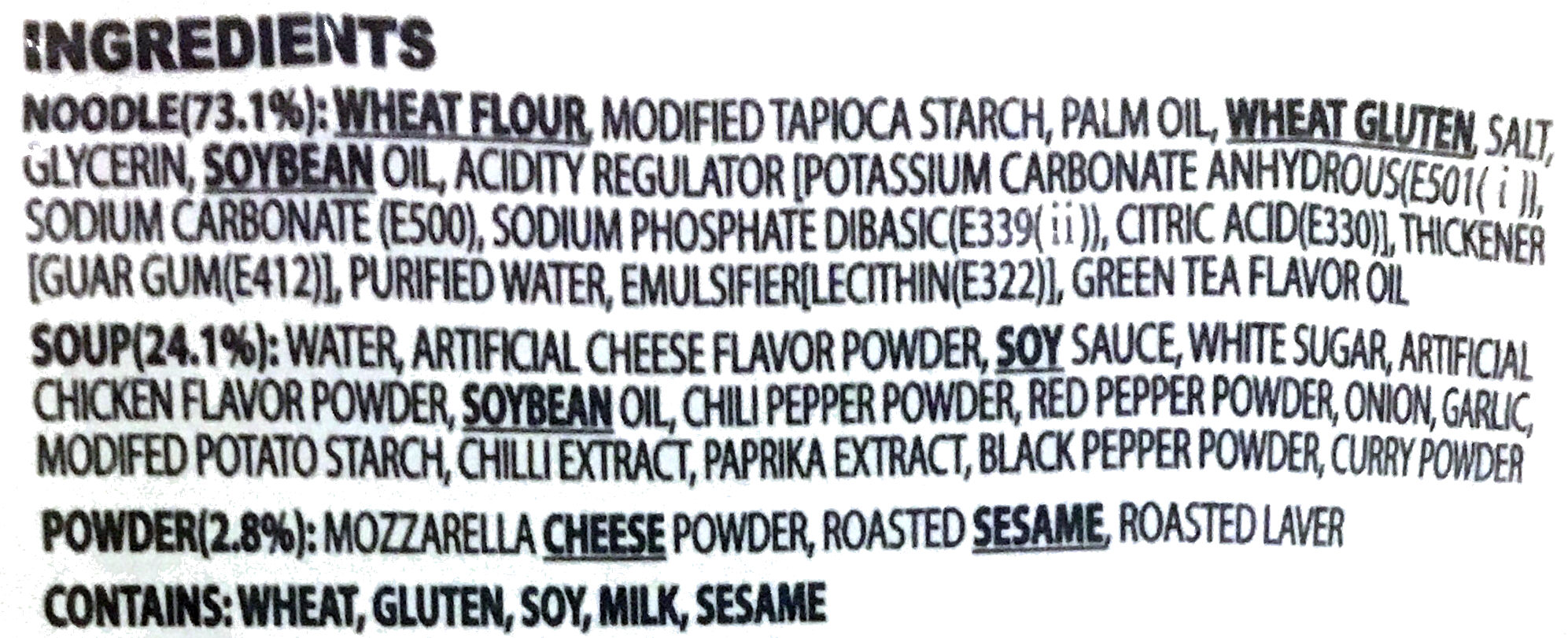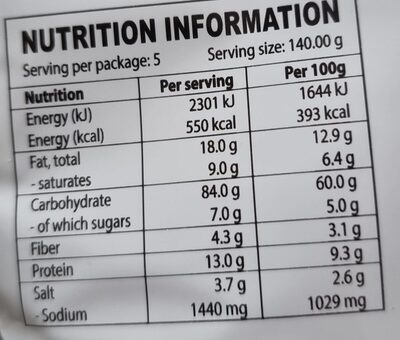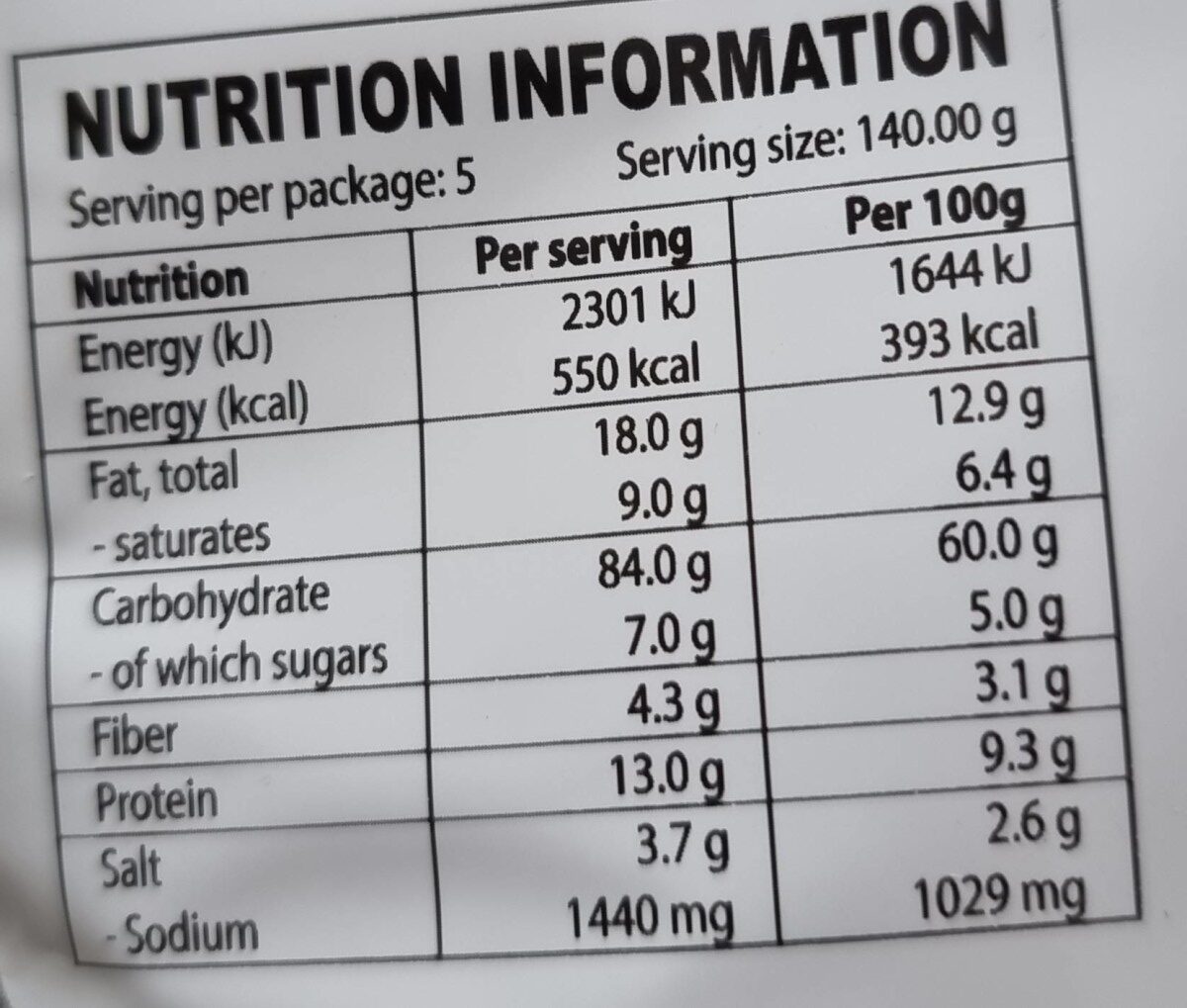Help us make food transparency the norm!
As a non-profit organization, we depend on your donations to continue informing consumers around the world about what they eat.
The food revolution starts with you!
Buldak Cheese - Samyang - 700 g
Buldak Cheese - Samyang - 700 g
This product page is not complete. You can help to complete it by editing it and adding more data from the photos we have, or by taking more photos using the app for Android or iPhone/iPad. Thank you!
×
Barcode: 8801073141780 (EAN / EAN-13)
Quantity: 700 g
Brands: Samyang
Categories: Plant-based foods and beverages, Plant-based foods, Cereals and potatoes, Cereals and their products, Pastas, Noodles
Labels, certifications, awards:
Halal
Stores: Woolworths
Matching with your preferences
Health
Ingredients
-
41 ingredients
noodle (73,1%) { wheat flour , modified tapioca starch, palm oil, wheat gluten, salt, glycerin, soybean oil, acidity regulator [potassium carbonate anhydrous (e501(i)), sodium carbonate (e500), sodium phosphate dibasic (e339(ii), citric acid (e330)], thickener [guar gum (e412)], purified water, emulsifier [lecithin (e322)], green tea flavor oil}, soup (24,1%) {water, artificial cheese flavor powder, soy sauce, white sugar, artificial chicken flavor powder, soybean oil, chili pepper powder, red pepper powder, onion, garlic, modified potato starch, chilli extract, paprika extract, black pepper powder, curry powder}, powder (2,8%) {mozzarella cheese powder, roasted sesame, roasted laver}, contains: wheat , gluten , soy , milk , sesameAllergens: Gluten, Milk, Sesame seeds, Soybeans
Food processing
-
Ultra processed foods
Elements that indicate the product is in the 4 - Ultra processed food and drink products group:
- Additive: E160c - Paprika extract
- Additive: E322 - Lecithins
- Additive: E412 - Guar gum
- Additive: E422 - Glycerol
- Ingredient: Emulsifier
- Ingredient: Gluten
- Ingredient: Thickener
Food products are classified into 4 groups according to their degree of processing:
- Unprocessed or minimally processed foods
- Processed culinary ingredients
- Processed foods
- Ultra processed foods
The determination of the group is based on the category of the product and on the ingredients it contains.
Additives
-
E322 - Lecithins
Lecithins are natural compounds commonly used in the food industry as emulsifiers and stabilizers.
Extracted from sources like soybeans and eggs, lecithins consist of phospholipids that enhance the mixing of oil and water, ensuring smooth textures in various products like chocolates, dressings, and baked goods.
They do not present any known health risks.
-
E322i - Lecithin
Lecithins are natural compounds commonly used in the food industry as emulsifiers and stabilizers.
Extracted from sources like soybeans and eggs, lecithins consist of phospholipids that enhance the mixing of oil and water, ensuring smooth textures in various products like chocolates, dressings, and baked goods.
They do not present any known health risks.
-
E330 - Citric acid
Citric acid is a natural organic acid found in citrus fruits such as lemons, oranges, and limes.
It is widely used in the food industry as a flavor enhancer, acidulant, and preservative due to its tart and refreshing taste.
Citric acid is safe for consumption when used in moderation and is considered a generally recognized as safe (GRAS) food additive by regulatory agencies worldwide.
-
E339ii - Disodium phosphate
Sodium phosphates: Sodium phosphate is a generic term for a variety of salts of sodium -Na+- and phosphate -PO43−-. Phosphate also forms families or condensed anions including di-, tri-, tetra-, and polyphosphates. Most of these salts are known in both anhydrous -water-free- and hydrated forms. The hydrates are more common than the anhydrous forms.Source: Wikipedia
-
E412 - Guar gum
Guar gum (E412) is a natural food additive derived from guar beans.
This white, odorless powder is valued for its remarkable thickening and stabilizing properties, making it a common ingredient in various food products, including sauces, dressings, and ice creams.
When used in moderation, guar gum is considered safe for consumption, with no known adverse health effects.
-
E422 - Glycerol
Glycerol: Glycerol -; also called glycerine or glycerin; see spelling differences- is a simple polyol compound. It is a colorless, odorless, viscous liquid that is sweet-tasting and non-toxic. The glycerol backbone is found in all lipids known as triglycerides. It is widely used in the food industry as a sweetener and humectant and in pharmaceutical formulations. Glycerol has three hydroxyl groups that are responsible for its solubility in water and its hygroscopic nature.Source: Wikipedia
-
E500 - Sodium carbonates
Sodium carbonates (E500) are compounds commonly used in food preparation as leavening agents, helping baked goods rise by releasing carbon dioxide when they interact with acids.
Often found in baking soda, they regulate the pH of food, preventing it from becoming too acidic or too alkaline. In the culinary world, sodium carbonates can also enhance the texture and structure of foods, such as noodles, by modifying the gluten network.
Generally recognized as safe, sodium carbonates are non-toxic when consumed in typical amounts found in food.
-
E500i - Sodium carbonate
Sodium carbonate: Sodium carbonate, Na2CO3, -also known as washing soda, soda ash and soda crystals, and in the monohydrate form as crystal carbonate- is the water-soluble sodium salt of carbonic acid. It most commonly occurs as a crystalline decahydrate, which readily effloresces to form a white powder, the monohydrate. Pure sodium carbonate is a white, odorless powder that is hygroscopic -absorbs moisture from the air-. It has a strongly alkaline taste, and forms a moderately basic solution in water. Sodium carbonate is well known domestically for its everyday use as a water softener. Historically it was extracted from the ashes of plants growing in sodium-rich soils, such as vegetation from the Middle East, kelp from Scotland and seaweed from Spain. Because the ashes of these sodium-rich plants were noticeably different from ashes of timber -used to create potash-, they became known as "soda ash". It is synthetically produced in large quantities from salt -sodium chloride- and limestone by a method known as the Solvay process. The manufacture of glass is one of the most important uses of sodium carbonate. Sodium carbonate acts as a flux for silica, lowering the melting point of the mixture to something achievable without special materials. This "soda glass" is mildly water-soluble, so some calcium carbonate is added to the melt mixture to make the glass produced insoluble. This type of glass is known as soda lime glass: "soda" for the sodium carbonate and "lime" for the calcium carbonate. Soda lime glass has been the most common form of glass for centuries. Sodium carbonate is also used as a relatively strong base in various settings. For example, it is used as a pH regulator to maintain stable alkaline conditions necessary for the action of the majority of photographic film developing agents. It acts as an alkali because when dissolved in water, it dissociates into the weak acid: carbonic acid and the strong alkali: sodium hydroxide. This gives sodium carbonate in solution the ability to attack metals such as aluminium with the release of hydrogen gas.It is a common additive in swimming pools used to raise the pH which can be lowered by chlorine tablets and other additives which contain acids. In cooking, it is sometimes used in place of sodium hydroxide for lyeing, especially with German pretzels and lye rolls. These dishes are treated with a solution of an alkaline substance to change the pH of the surface of the food and improve browning. In taxidermy, sodium carbonate added to boiling water will remove flesh from the bones of animal carcasses for trophy mounting or educational display. In chemistry, it is often used as an electrolyte. Electrolytes are usually salt-based, and sodium carbonate acts as a very good conductor in the process of electrolysis. In addition, unlike chloride ions, which form chlorine gas, carbonate ions are not corrosive to the anodes. It is also used as a primary standard for acid-base titrations because it is solid and air-stable, making it easy to weigh accurately.Source: Wikipedia
-
E501 - Potassium carbonates
Potassium carbonate: Potassium carbonate -K2CO3- is a white salt, which is soluble in water -insoluble in ethanol- and forms a strongly alkaline solution. It can be made as the product of potassium hydroxide's absorbent reaction with carbon dioxide. It is deliquescent, often appearing a damp or wet solid. Potassium carbonate is used in the production of soap and glass.Source: Wikipedia
-
E501i - Potassium carbonate
Potassium carbonate: Potassium carbonate -K2CO3- is a white salt, which is soluble in water -insoluble in ethanol- and forms a strongly alkaline solution. It can be made as the product of potassium hydroxide's absorbent reaction with carbon dioxide. It is deliquescent, often appearing a damp or wet solid. Potassium carbonate is used in the production of soap and glass.Source: Wikipedia
Ingredients analysis
-
Palm oil
Ingredients that contain palm oil: Palm oil
-
Non-vegan
Non-vegan ingredients: MozzarellaSome ingredients could not be recognized.
We need your help!
You can help us recognize more ingredients and better analyze the list of ingredients for this product and others:
- Edit this product page to correct spelling mistakes in the ingredients list, and/or to remove ingredients in other languages and sentences that are not related to the ingredients.
- Add new entries, synonyms or translations to our multilingual lists of ingredients, ingredient processing methods, and labels.
If you would like to help, join the #ingredients channel on our Slack discussion space and/or learn about ingredients analysis on our wiki. Thank you!
-
Vegetarian status unknown
Unrecognized ingredients: Potassium-carbonate-anhydrous, Sodium-phosphate-dibasic, E339ii, Soup, Artificial-cheese-flavor-powder, Artificial-chicken-flavor-powder, PowderSome ingredients could not be recognized.
We need your help!
You can help us recognize more ingredients and better analyze the list of ingredients for this product and others:
- Edit this product page to correct spelling mistakes in the ingredients list, and/or to remove ingredients in other languages and sentences that are not related to the ingredients.
- Add new entries, synonyms or translations to our multilingual lists of ingredients, ingredient processing methods, and labels.
If you would like to help, join the #ingredients channel on our Slack discussion space and/or learn about ingredients analysis on our wiki. Thank you!
-
Details of the analysis of the ingredients
We need your help!
Some ingredients could not be recognized.
We need your help!
You can help us recognize more ingredients and better analyze the list of ingredients for this product and others:
- Edit this product page to correct spelling mistakes in the ingredients list, and/or to remove ingredients in other languages and sentences that are not related to the ingredients.
- Add new entries, synonyms or translations to our multilingual lists of ingredients, ingredient processing methods, and labels.
If you would like to help, join the #ingredients channel on our Slack discussion space and/or learn about ingredients analysis on our wiki. Thank you!
: noodle 73.1% (wheat flour, modified tapioca starch, palm oil, wheat gluten, salt, glycerin, soybean oil, acidity regulator (potassium carbonate anhydrous (e501i), sodium carbonate (e500), sodium phosphate dibasic, e339ii, citric acid (e330)), thickener (), purified water, emulsifier (), green tea flavor oil), soup 24.1% (water, artificial cheese flavor powder, soy sauce, white sugar, artificial chicken flavor powder, soybean oil, chili pepper, red pepper, onion, garlic, modified potato starch, chilli, paprika extract, black pepper, curry), powder 2.8% (mozzarella cheese, sesame, laver)- noodle -> en:noodle - vegan: maybe - vegetarian: maybe - percent_min: 73.1 - percent: 73.1 - percent_max: 73.1
- wheat flour -> en:wheat-flour - vegan: yes - vegetarian: yes - ciqual_proxy_food_code: 9410 - percent_min: 6.09166666666667 - percent_max: 73.1
- modified tapioca starch -> en:modified-tapioca-starch - vegan: yes - vegetarian: yes - ciqual_proxy_food_code: 9510 - percent_min: 0 - percent_max: 36.55
- palm oil -> en:palm-oil - vegan: yes - vegetarian: yes - from_palm_oil: yes - ciqual_food_code: 16129 - percent_min: 0 - percent_max: 24.3666666666667
- wheat gluten -> en:wheat-gluten - vegan: yes - vegetarian: yes - percent_min: 0 - percent_max: 18.275
- salt -> en:salt - vegan: yes - vegetarian: yes - ciqual_food_code: 11058 - percent_min: 0 - percent_max: 2.6
- glycerin -> en:e422 - vegan: maybe - vegetarian: maybe - percent_min: 0 - percent_max: 2.6
- soybean oil -> en:soya-oil - vegan: yes - vegetarian: yes - from_palm_oil: no - ciqual_food_code: 17420 - percent_min: 0 - percent_max: 2.6
- acidity regulator -> en:acidity-regulator - percent_min: 0 - percent_max: 2.6
- potassium carbonate anhydrous -> en:potassium-carbonate-anhydrous - percent_min: 0 - percent_max: 2.6
- e501i -> en:e501i - vegan: yes - vegetarian: yes - percent_min: 0 - percent_max: 2.6
- sodium carbonate -> en:e500i - vegan: yes - vegetarian: yes - percent_min: 0 - percent_max: 1.3
- e500 -> en:e500 - vegan: yes - vegetarian: yes - percent_min: 0 - percent_max: 1.3
- sodium phosphate dibasic -> en:sodium-phosphate-dibasic - percent_min: 0 - percent_max: 0.866666666666667
- e339ii -> en:e339ii - percent_min: 0 - percent_max: 0.65
- citric acid -> en:e330 - vegan: yes - vegetarian: yes - percent_min: 0 - percent_max: 0.52
- e330 -> en:e330 - vegan: yes - vegetarian: yes - percent_min: 0 - percent_max: 0.52
- potassium carbonate anhydrous -> en:potassium-carbonate-anhydrous - percent_min: 0 - percent_max: 2.6
- thickener -> en:thickener - percent_min: 0 - percent_max: 0
- purified water -> en:filtered-water - vegan: yes - vegetarian: yes - ciqual_food_code: 18066 - percent_min: 0 - percent_max: 0
- emulsifier -> en:emulsifier - percent_min: 0 - percent_max: 0
- green tea flavor oil -> en:green-tea-aroma-oil - vegan: yes - vegetarian: yes - ciqual_food_code: 18155 - percent_min: 0 - percent_max: 0
- soup -> en:soup - percent_min: 24.1 - percent: 24.1 - percent_max: 24.1
- water -> en:water - vegan: yes - vegetarian: yes - ciqual_food_code: 18066 - percent_min: 1.60666666666667 - percent_max: 24.1
- artificial cheese flavor powder -> en:artificial-cheese-flavor-powder - percent_min: 0 - percent_max: 12.05
- soy sauce -> en:soy-sauce - vegan: maybe - vegetarian: maybe - ciqual_food_code: 11104 - percent_min: 0 - percent_max: 8.03333333333333
- white sugar -> en:white-sugar - vegan: yes - vegetarian: yes - ciqual_food_code: 31016 - percent_min: 0 - percent_max: 5
- artificial chicken flavor powder -> en:artificial-chicken-flavor-powder - percent_min: 0 - percent_max: 4.82
- soybean oil -> en:soya-oil - vegan: yes - vegetarian: yes - from_palm_oil: no - ciqual_food_code: 17420 - percent_min: 0 - percent_max: 4.01666666666667
- chili pepper -> en:chili-pepper - vegan: yes - vegetarian: yes - ciqual_food_code: 20151 - percent_min: 0 - percent_max: 3.44285714285714
- red pepper -> en:red-bell-pepper - vegan: yes - vegetarian: yes - ciqual_food_code: 20087 - percent_min: 0 - percent_max: 3.0125
- onion -> en:onion - vegan: yes - vegetarian: yes - ciqual_food_code: 20034 - percent_min: 0 - percent_max: 2.67777777777778
- garlic -> en:garlic - vegan: yes - vegetarian: yes - ciqual_food_code: 11000 - percent_min: 0 - percent_max: 2.41
- modified potato starch -> en:modified-potato-starch - vegan: yes - vegetarian: yes - ciqual_proxy_food_code: 9510 - percent_min: 0 - percent_max: 2.19090909090909
- chilli -> en:chili-pepper - vegan: yes - vegetarian: yes - ciqual_food_code: 20151 - percent_min: 0 - percent_max: 2.00833333333333
- paprika extract -> en:e160c - vegan: yes - vegetarian: yes - percent_min: 0 - percent_max: 1.85384615384615
- black pepper -> en:black-pepper - vegan: yes - vegetarian: yes - ciqual_food_code: 11015 - percent_min: 0 - percent_max: 1.72142857142857
- curry -> en:curry - vegan: yes - vegetarian: yes - ciqual_food_code: 11005 - percent_min: 0 - percent_max: 1.60666666666667
- powder -> en:powder - percent_min: 2.8 - percent: 2.8 - percent_max: 2.8
- mozzarella cheese -> en:mozzarella - vegan: no - vegetarian: maybe - ciqual_food_code: 19590 - percent_min: 0.933333333333333 - percent_max: 2.8
- sesame -> en:sesame - vegan: yes - vegetarian: yes - ciqual_food_code: 15010 - percent_min: 0 - percent_max: 1.4
- laver -> en:laver - vegan: yes - vegetarian: yes - ciqual_proxy_food_code: 20984 - percent_min: 0 - percent_max: 0.933333333333332
Nutrition
-
Poor nutritional quality
⚠ ️Warning: the amount of fruits, vegetables and nuts is not specified on the label, it was estimated from the list of ingredients: 0This product is not considered a beverage for the calculation of the Nutri-Score.
Positive points: 3
- Proteins: 5 / 5 (value: 9.3, rounded value: 9.3)
- Fiber: 3 / 5 (value: 3.1, rounded value: 3.1)
- Fruits, vegetables, nuts, and colza/walnut/olive oils: 0 / 5 (value: 0.538056640625, rounded value: 0.5)
Negative points: 21
- Energy: 4 / 10 (value: 1644, rounded value: 1644)
- Sugars: 1 / 10 (value: 5, rounded value: 5)
- Saturated fat: 6 / 10 (value: 6.4, rounded value: 6.4)
- Sodium: 10 / 10 (value: 1040, rounded value: 1040)
The points for proteins are not counted because the negative points are greater or equal to 11.
Nutritional score: (21 - 3)
Nutri-Score:
-
Nutrient levels
-
Fat in moderate quantity (12.9%)
What you need to know- A high consumption of fat, especially saturated fats, can raise cholesterol, which increases the risk of heart diseases.
Recommendation: Limit the consumption of fat and saturated fat- Choose products with lower fat and saturated fat content.
-
Saturated fat in high quantity (6.4%)
What you need to know- A high consumption of fat, especially saturated fats, can raise cholesterol, which increases the risk of heart diseases.
Recommendation: Limit the consumption of fat and saturated fat- Choose products with lower fat and saturated fat content.
-
Sugars in moderate quantity (5%)
What you need to know- A high consumption of sugar can cause weight gain and tooth decay. It also augments the risk of type 2 diabetes and cardio-vascular diseases.
Recommendation: Limit the consumption of sugar and sugary drinks- Sugary drinks (such as sodas, fruit beverages, and fruit juices and nectars) should be limited as much as possible (no more than 1 glass a day).
- Choose products with lower sugar content and reduce the consumption of products with added sugars.
-
Salt in high quantity (2.6%)
What you need to know- A high consumption of salt (or sodium) can cause raised blood pressure, which can increase the risk of heart disease and stroke.
- Many people who have high blood pressure do not know it, as there are often no symptoms.
- Most people consume too much salt (on average 9 to 12 grams per day), around twice the recommended maximum level of intake.
Recommendation: Limit the consumption of salt and salted food- Reduce the quantity of salt used when cooking, and don't salt again at the table.
- Limit the consumption of salty snacks and choose products with lower salt content.
-
-
Nutrition facts
Nutrition facts As sold
for 100 g / 100 mlAs sold
per serving (140g)Compared to: Noodles Energy 1,644 kj
(393 kcal)2,300 kj
(550 kcal)+66% Fat 12.9 g 18.1 g +98% Saturated fat 6.4 g 8.96 g +115% Carbohydrates 60 g 84 g +73% Sugars 5 g 7 g +178% Fiber 3.1 g 4.34 g +77% Proteins 9.3 g 13 g +80% Salt 2.6 g 3.64 g +61% Fruits‚ vegetables‚ nuts and rapeseed‚ walnut and olive oils (estimate from ingredients list analysis) 0.538 % 0.538 %
Environment
-
Eco-Score not computed - Unknown environmental impact
We could not compute the Eco-Score of this product as it is missing some data, could you help complete it?Could you add a precise product category so that we can compute the Eco-Score? Add a category
Packaging
-
Packaging with a high impact
-
Packaging parts
1 x Wrapper 5 (Plastic/aluminium: 6.3 g)
5 x Wrapper 1 (Plastic/aluminium: 3.3 g)
5 x Packet 1 (O 7 - Other plastics: 0.7 g)
5 x Packet 1 (Plastic: 2 g)
-
Packaging materials
Material % Packaging weight Packaging weight per 100 g of product Plastic 37.2% 13.5 g 1.9 g
-
Transportation
-
Origins of ingredients
Missing origins of ingredients information
⚠ ️ The origins of the ingredients of this product are not indicated.
If they are indicated on the packaging, you can modify the product sheet and add them.
If you are the manufacturer of this product, you can send us the information with our free platform for producers.Add the origins of ingredients for this product Add the origins of ingredients for this product
Threatened species
-
Contains palm oil
Drives deforestation and threatens species such as the orangutan
Tropical forests in Asia, Africa and Latin America are destroyed to create and expand oil palm tree plantations. The deforestation contributes to climate change, and it endangers species such as the orangutan, the pigmy elephant and the Sumatran rhino.
Report a problem
-
Incomplete or incorrect information?
Category, labels, ingredients, allergens, nutritional information, photos etc.
If the information does not match the information on the packaging, please complete or correct it. Open Food Facts is a collaborative database, and every contribution is useful for all.
Data sources
Product added on by kiliweb
Last edit of product page on by odinh.
Product page also edited by archanox, inf, roboto-app, segundo, yuka.sY2b0xO6T85zoF3NwEKvlhdAeeXB_TT-BT34pF2N3-jWMqGzPsNJ4rmnEKs, yuka.sY2b0xO6T85zoF3NwEKvlkZidNrvoD72Ki3VwHSH1MihMZrQSvdi7brFb6s.












